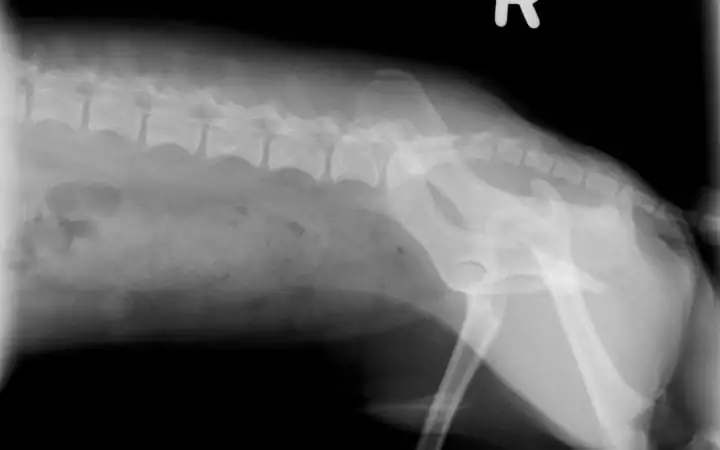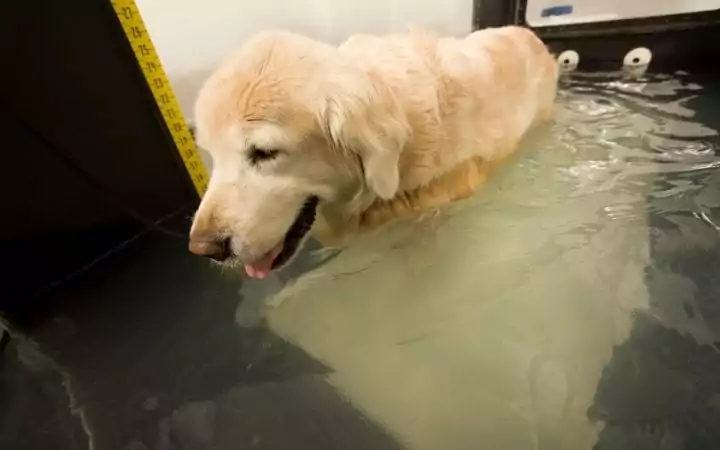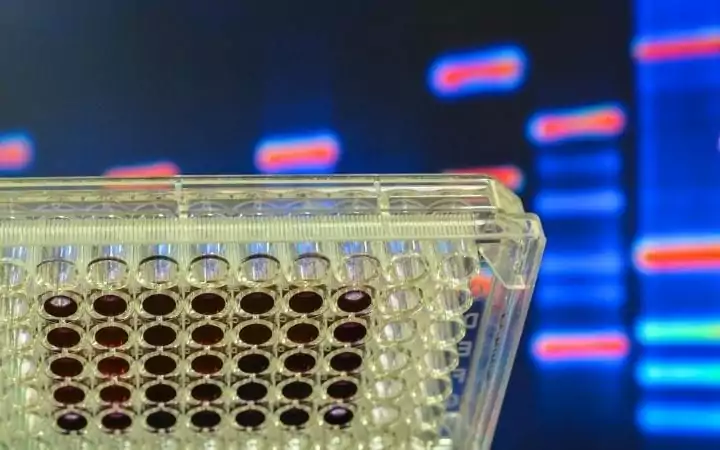Degenerative Myelopathy is a tough diagnosis for any four-legged friend and us as humans to watch. But take a read below to learn what symptoms to look out for and what you can do to help. We’re also getting real about what we can all do to help prevent it in future generations!
What is Degenerative Myelopathy?
Degenerative myelopathy (DM) is a disease of the spinal cord. It’s progressive, meaning it gets worse over time, in the end, leaving the dog unable to walk. As it is progressive, it also explains why it more often affects older dogs, typically in the age bracket of eight to fourteen years. Usually, it takes from six months to a year, from the onset of symptoms, until the dog becomes paraplegic (lame in two limbs).
What are the causes of Degenerative Myelopathy?
Myelopathy is a term for breaking down the spinal cord matter. What happens with Degenerative Myelopathy in dogs is that the spinal cord’s white matter is broken down over time. It is in some ways similar to the human disease Amyotrophic Lateral Sclerosis – known as ALS.
The exact cause as to why the white matter of the spinal cord gets broken down in these old dogs is unknown. It is associated with a genetic abnormality in dogs. The abnormality causes a mutation in the coding of a protein called Superoxide Dismutase (SD). Behind the fancy name, the job of this protein is to break down the free radicals in the body.
Free radicals are a normal by-product of metabolism in the body, but it is important that they’re broken down and removed. This is done by enzymes and proteins in the body, like SD. If production and accumulation become excessive, it can be harmful. This is what is believed to be the cause of DM in dogs.
What are the clinical signs, and how is it diagnosed?
The most important thing to mention first about Degenerative Myelopathy is that it is not painful. Your dog will not be experiencing any pain. This is also why it is sometimes difficult to diagnose, so it’s important to know some of the symptoms.
Age
DM usually affects old dogs. Some as early as five years, but most often dogs older than eight years. Some dogs may not be affected until an older age, though, and there are reports of it happening in young dogs on rare occasions. So age is not a gold standard for diagnosis.
Lameness
The first symptom will often be a subtle weakness in one of the hindlimbs and maybe intermediate lameness. There should be no pain associated with the lameness.
Lack of feeling
An early clinical sign is also “knuckle-walk.” Here the hind paws turn under, so the dog is walking on its knuckles. This is because the dog lacks any feeling in its paws. It can’t feel that it is walking abnormally. It can also cause the hind feet to scrape across the ground when walking or running.
Ataxia (lack of coordination)
Another subtle symptom is also that your dog may struggle to get up after having lied down. Or perhaps the dog falls over when pushed from the side.
As can be seen above, the symptoms are very diffuse. This means that many diseases have similar symptomatic patterns as Degenerative Myelopathy. Any condition that affects the dog’s spinal cord can have similar symptoms. This also makes it difficult to diagnose.
A comprehensive clinical examination with a veterinarian is the first step. Often this will include a neurological examination as well. Here the suspected diagnosis is given based on clinical signs, breed, and age. Laboratory diagnostics may then be included to further investigate. This may include:
- Blood tests
- X-rays
- MRI
- Cerebrospinal fluid sampling
In the end – in theory – histopathology of the spinal cord is necessary for a definitive diagnosis. But, the diagnosis is often given based on clinical signs, laboratory findings, and the lack of other symptoms.
What are the stages of Degenerative Myelopathy, and how can you help your dog?
Degenerative Myelopathy is split into five different stages, based on the clinical symptoms. In each of the stages, your veterinarian will be able to help and guide you on what is best for your dog and what you can do to help it as well!
Early-stage
In the beginning, it is very difficult to diagnose and perhaps even notice DM. It often only includes a very minor weakness in the hind legs – possibly accompanied by a small change in the dogs’ walk. One way of noticing if your dog is walking weirdly is to check its nails. Are they wearing down differently? Uneven wear on the innermost nails is an early sign of DM.
Early to Mid-stage
Here the symptoms might become much more apparent. It might begin to struggle to stand up and maintain balance. It might also be more visible that your dog is losing muscle mass in its hind legs.
In this stage, it might be useful to help your dog standing or maintaining balance. This can be done with a support leash or a walking harness. These allow you to help your dog stand by lifting their legs slightly and easing their struggle when walking.
Early Late-stage
In this stage, there will be significant changes in your dog’s mobility. Their movements will become jerkier, and it might become impossible for your dog to maintain its balance.
In this stage, a support harness or leash is essential as your dog will not be able to stand at all.
Late-stage
Degenerative Myelopathy can progress very quickly. Your dog will now have lost all mobility in its hind legs. It is most likely not able to get up or stand, even when supported. In these cases, it will be worth looking into getting your dog a wheelchair! Luckily there’s plenty of great options. So take a look at “What to do when your dog needs a wheelchair.”
How does degenerative myelopathy get treated?
Unfortunately, there’s no known treatment for Degenerative Myelopathy. It is an irreversible and progressive disease. As it is not a painful condition, many dogs can be supported and maintain an acceptable quality of life.
This means that many owners choose the palliative care pathway before euthanasia. This will include helpful equipment like supporting harnesses or mobility slings. At some point, a wheelchair will also be necessary for your furry friend.
Many veterinarians will also either conduct some rehabilitation or refer you to a specialist. A rehabilitation service will be able to help the dog maintain mobility for as long as possible. Physiotherapy and hydrotherapy (water-walker) are also often recommended. This may play a part in potentially delaying the progression of the neurological symptoms. The goal is to keep the dog on its feet for as long as possible.
DM progresses at different rates in every dog. But, as there is no treatment available, the prognosis is guarded. The disease will eventually progress to the front limbs, meaning the dog will no longer be able to stand or walk – even if supported. In these cases, it will often be recommended to say goodbye to your best friend.
Are there breeds that are predisposed to Degenerative Myelopathy?
Any dog can be affected by Degenerative Myelopathy, but some breeds are more predisposed genetically. These breeds are especially:
- German Shepherds
- Corgis
- Boxers
- Bernese Mountain dogs
As DM is a genetically inherited disease, DNA testing can help determine whether a dog is at risk for developing the disease. It can also be useful if you’re considering breeding with your dog. A DNA test will diminish the risk of any offspring developing DM and reduce the gene frequency in future generations. Meaning fewer dogs will get sick. It’s a pain-free check – just a cheek swab is needed.
This has to be done by a veterinarian and often sent away for laboratory testing. The results will be split into one of three categories:
Normal
The dog is homozygous N/N. It does not carry the gene for Degenerative Myelopathy. It does not mean it cannot become sick from DM, but it is doubtful. It is also improbable that the dog’s offspring will ever develop DM.
Carrier (A/N)
This dog has one mutated copy of the gene and one normal copy. This means the dog is unlikely to develop DM itself. But, it can give the gene to any offspring it may produce. It needs to be carefully bred, if at all, to reduce the risk of DM in offspring.
At-risk (A/A)
This dog has two copies of the mutated gene. It is at risk of developing Degenerative Myelopathy itself. But, not all dogs with the mutation will show clinical signs; whether this is because the disease just stays dormant or if the dog passes away before onset is still debated.
Dogs with A/A mutations will definitely pass on the mutation to any offspring. It is, therefore, not recommendable to breed these individuals.
Summary
It is never pleasant to watch your best friend being sick. Especially when it’s a devastating disease like Degenerative Myelopathy, this is why it is so important to have dogs tested before breeding, to avoid future puppies being at risk. If your dog is sick, you can do a lot to support and help it, to give it a happy and comfortable life for as long as possible.






